 [In the first installment of this post I provided a transcription of the full text of a recently discovered May 8, 1944 set of in-house protocols for the annotation, intake, and processing of all photographs by LIFE‘s London-based team of photographers — seven staffers plus freelancer Robert Capa, commissioned especially for the invasion coverage.
[In the first installment of this post I provided a transcription of the full text of a recently discovered May 8, 1944 set of in-house protocols for the annotation, intake, and processing of all photographs by LIFE‘s London-based team of photographers — seven staffers plus freelancer Robert Capa, commissioned especially for the invasion coverage.
This document pertains to and illuminates several aspects of our investigation. For that reason I solicited responses thereto from the members of our team with professional experience as photographers: J. Ross Baughman, photojournalist, combat photographer, picture editor, and author; Rob McElroy, photographer and photo historian; and Tristan da Cunha, photographer and darkroom/post-production technician.
I’ve consolidated all of our observations and analyses, to make them as clear as possible. Click here for part 1, and here for part 3.— A.D.C.]
•
LIFE Magazine’s Protocols for D-Day Photos (b)
… It seems reasonable to assume that this document did not emerge spontaneously from LIFE‘s London photo division, nor that only this department generated such an advisory. More likely, an order came down from much higher up the chain of command at TIME-LIFE, requiring those in charge of all departments — or at least all the departments that would be involved in D-Day coverage — to produce comparable protocols well in advance of D-Day. That would enable them to identify procedural gaps before the invasion and, as this one has it, “get all the kinks ironed out ahead of time,” guaranteeing coordination both within and between the departments.
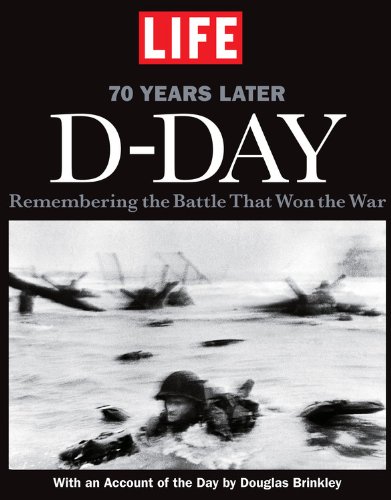
“LIFE D-DAY: 70 Years Later” (2014), cover
Which leads me to suggest, once again, that Time, Inc. has missed a bet by not producing an anniversary volume specifically dedicated to the making of LIFE‘s D-Day issue — protocols, layout boards, notes, memoranda, edited text drafts, etc. That would have proved a worthy endeavor for the late LIFE historian John Loengard to undertake, and would make a valuable addition to the D-Day literature in the future.
Be that as it may, most such protocols would not have involved the sudden introduction of radically new and previously untested methods. Instead, they would for the most part have formalized or reiterated previously established standard operating procedures. Many of those would already have existed on paper, in carbon-copied and/or mimeographed form, as in-house handbooks for use by new employees as reference, etc., so that all involved were literally and metaphorically on the same page. (Codifying departmental routines and know-how ensures consistency of output, and smooth workflow transitions as staff come and go.)
In short, with one notable exception (to be discussed later) these protocols most likely came as old news to the photographers and the darkroom staff. They did not represent any innovation going forward, but instead annotated how things normally got done. For that reason, they seem intended more to reassure the upper echelon of management that the photo division had everything under control than to inform the photographers and darkroom workers, who knew all this by heart.
Moreover, these protocols describe — at least insofar as the darkroom procedures go — commonplace, everyday methods, sketched here in rudimentary terms. The proposed system for annotating rolls of film, first by the photographers and then by the darkroom staff, seems convoluted and — for roll film exposed in combat situations — impractical. I suspect it got honored more in the breach than the observance. (More on that anon.) Nonetheless, its articulation here inspires confidence that they have addressed these questions and have the situation well in hand.
Who Wrote This?
Because it bears John Morris’s name, let’s remind ourselves of his status in the TIME-LIFE hierarchy.
Morris’s official title on the LIFE masthead for the D-Day issue (datelined June 19, 1944) reads “assistant picture editor.” It appears the same way inn preceding and subsequent issues. It is the only masthead title in all lower-case letters, subsumed under the boldface rubric STAFF PHOTOGRAPHERS.
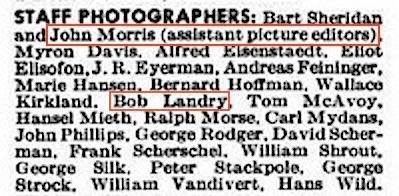
LIFE masthead, John Morris and Bob Landry, June 19, 1944 issue
•
Younger than all but one of the London-based staffers (and Capa), less professionally accomplished than any of them, and with no combat experience under his belt, Morris had no seniority, virtually no authority in this situation, and extremely limited informal influence. As I’ve pointed out previously, he hadn’t had any say in the hiring of these staffers, nor in the commissioning of Capa. All of them had been on the job for some time when he showed up in September 1943. He also found the darkroom staff already in place when he arrived.
He had no authority to fire any of them. He couldn’t assign them to stories, though he had permission to cook up feature ideas and try to persuade the editors above him and the photographers to take those on. (Mostly unsuccessfully, even by own account.) Certainly he had no say in regard to their D-Day assignments.
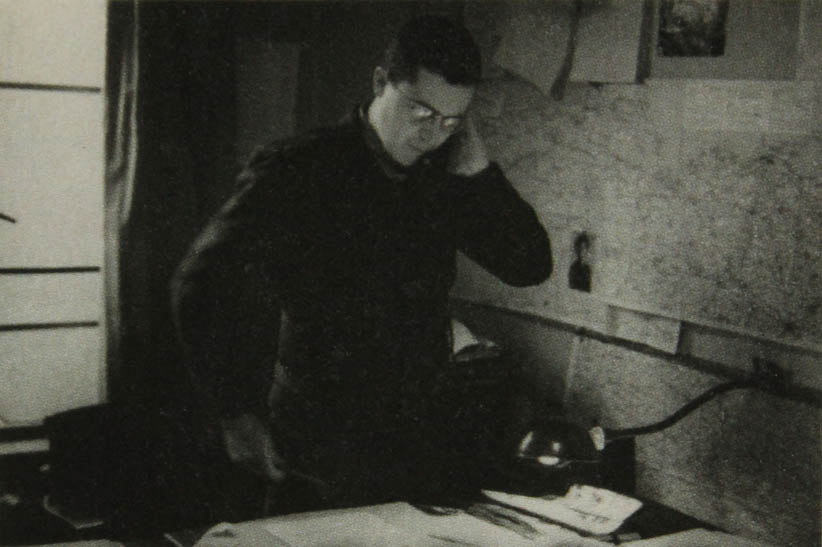
John Morris, LIFE office, London, 1944. Photo: David Scherman.
•
Not surprisingly, then, in his recollection of his time in the London office Morris leaves unclear his exact function as “assistant picture editor.” He recalls in considerable detail his weekly routine of shepherding the censor-approved images and captions through a second round of censorial filtration, and then hustling them to the courier who would take them to the flight that would serve as the first leg of their journey stateside. And, preparing for that, he implies that either he typed up the photographers’ handwritten caption notes himself or supervised a secretary’s doing so.
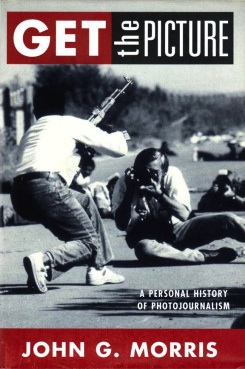
John Morris, “Get the Picture” (1998), cover.
But just exactly what picture editing did he do? Almost certainly he selected from the incoming images those that went out to the press pool for widespread distribution; this had to happen on the spot in London, too quickly to allow for the home office to weigh in. However, in terms of what LIFE eventually published, all final decisions got made in New York. Did Morris perform preliminary, rough edits on photos as they came in? Or did he simply send everything on for Ed Thompson and Wilson Hicks to consider?
In his 1998 memoir Get the Picture Morris proves not just exceptionally vague but completely silent on the subject of his actual duties in his role. Excepting his almost entirely fictionalized version of what happened with Capa’s D-Day photos, he mentions not even a single story that he originated, no assignment on which he collaborated with any of the photographers and writers, and no editorial process in which he participated. Given his demonstrated tendency to self-aggrandize, we could infer that, beyond picking what the press pool got, he had no editorial role to speak of.
He also had no expertise or guidance to offer the photographers. Consequently, though he refers to them proprietarily as “My own invasion team … my team” in Get the Picture, Morris hardly qualified as either that team’s captain or its coach. He ranked closer to bat boy.
•
Morris prided himself on knowing nothing about cameras, films, darkroom procedures, etc. He said as much himself, and his implausible film-cabinet-doors-accidentally-left-closed explanation of the fictional emulsion melt confirms that.
So I doubt very much that he authored any substantial portion of this set of instructions. Per his opening paragraph, “The following system of identification of negatives sent in from the field by staff photographers has been suggested for handling invasion pictures. Let’s put it into effect now and get all the kinks ironed out ahead of time.” (Emphasis added.)
From whence came those “suggestions”? Most likely the protocols got written up by LIFE‘s London darkroom chief, H. C. “Braddy” Bradshaw, perhaps in consultation with staff photographer Hans Wild, who had preceded Bradshaw as darkroom chief. Due to his country of birth, Wild, a naturalized British citizen and German emigré, was prohibited from photographing anything sensitive to the war effort. So, unable to participate in the invasion coverage, he would also be present in the darkroom for the D-Day processing marathon, charged at least in part with keeping Morris informed via in-house phone about the progress of production and the quality of the results.
•
In the context of all this boilerplate, one might easily miss what I consider the most revelatory passage of this document:
The censors are now deciding whether or not they can work from 35 m.m. contact prints. In the event that they demand enlargements, the above system will have to be modified.
Clearly John Morris wrote this paragraph himself. What does this signify, and why does it matter?
To recap some previous research, we know now that the incoming D-Day films and caption sheets from Robert Capa and David Scherman went through the following intake system, as required by Supreme Headquarters Allied Expeditionary Forces (SHAEF):
- On the morning of June 7, 1944, shortly after arriving back on the English coast, Capa and Scherman hand-delivered their D-Day coverage to a SHAEF outpost at Portsmouth, on the English coast.
- A military courier transported them by motorcycle up the coast to the offices of SHAEF’s Ministry of Information (MoI) at the University of London, where they got logged in.
- A SHAEF/MoI officer then transported those materials to the Time-Life offices in London for processing.
- Processing took place under the watchful eye of said SHAEF officer, with only the darkroom staff allowed to eyeball the results. Morris was excluded from that procedure.
- The officer then returned the processed negatives and prints therefrom, plus caption notes, to the MoI for censoring.
- The MoI had no obligation to justify or otherwise explain the censorship of anything. They had Operation Fortitude South — the disinformation campaign planned to confuse the Germans about the invasion — well underway. That provided the basis for many censorial decisions that might have seemed arbitrary.
- In any case, whatever the censors approved for publication got returned to Morris for distribution to the press pool and forwarding to LIFE‘s New York office for use in its D-Day issue.
- The remainder of Capa’s and Scherman’s coverage — censored images (both negatives and prints) and caption notes — vanished into the SHAEF/MoI files. Their ultimate fate remains undetermined.
•
With time of the essence, the import of the question embedded in that paragraph becomes clear. Implicitly, the censors felt confident that they could work effectively from contact prints of 2-1/4″ 120-film negatives (and, of course, from contacts of the even larger 4×5″ negatives that Capa unexpectedly sent in). If they could also work from contact prints of the much smaller 35mm. negatives, that would save the LIFE darkroom staff much time and effort as they rushed to meet the looming deadline. Otherwise, if the censors required enlargements, Bradshaw’s crew would have to churn out hundreds of prints even to create a single set representing the entirety of these two photographers’ 35mm. coverage of the invasion.
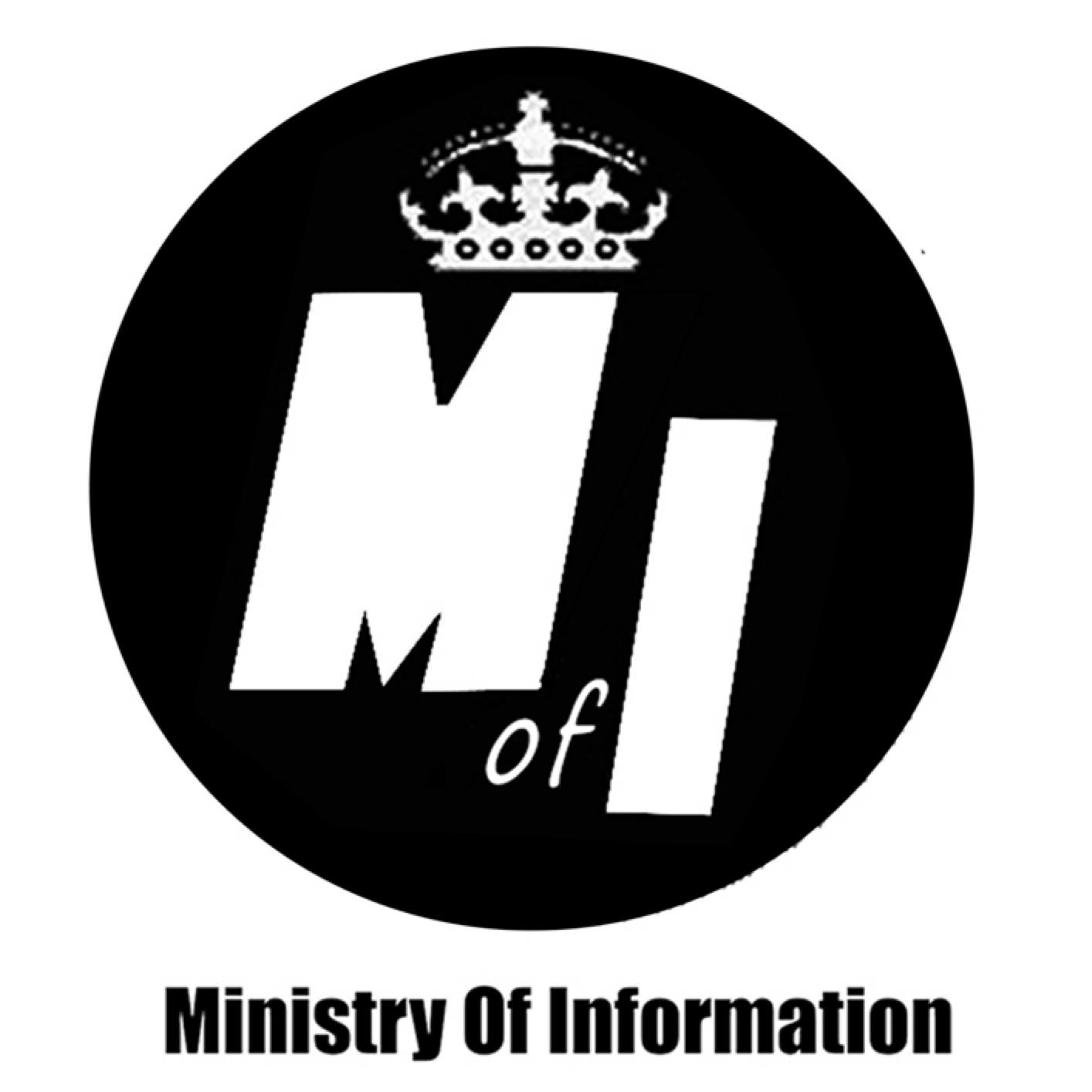
Ministry of Information logo
Morris’s statement that “[t]he censors are now deciding whether or not they can work from 35 m.m. contact prints” certainly suggests that, up until then, the censors had “demanded” enlargements of all 35mm negatives as the basis for their determinations. Implicitly, the various civilian photo departments whose accredited photographers would cover the invasion (and not just LIFE magazine’s crew) had collectively asked the MoI if they could save precious time by skipping the production of enlargements of all 35mm negatives, and in early May their request remained under consideration.
Either way, the censors’ involvement in this stage of production readily explains the missing Capa negatives, which came to Morris pre-censored. Because it undercuts and obviates Capa’s and Morris’s fabulation of the dramatic darkroom disaster, both needed to elide that step in their accounts of the proceedings — and did so throughout their lives. This paragraph is the only mention thereof in anything so far discovered that bears Morris’s name. Consequently, we’ll likely never know whether the MoI forced the LIFE darkroom to generate enlargements of all Capa’s and Scherman’s 35mm. negatives, or spared them that chore and saved Bradshaw and his “darkroom lads” a great deal of time and work.
•
Of course, after receiving the MoI “cut” of the coverage, LIFE‘s darkroom staff would still need to make the four sets of enlargements indicated in Morris’s earlier addition to the protocols:
Each roll will, however, come in from the photographer with a distinct caption sheet, and this will be transcribed here in quadruplicate on a separate sheet of paper, with one copy for the censor, one for the Pool, one for New York and one for our file.
If those four targets would automatically receive transcribed copies of the caption sheets, it stands to reason that they would also receive sets of enlargements of the images to which the captions referred. But the original set of images would have become considerably reduced — first, by whatever the censors excised from the batch; second, in terms of the set going to the press pool, by whatever Morris picked to submit to the pool, surely only a dozen or so of the best. The complete set of negatives approved by the censors, and possibly contact prints thereof, and perhaps also enlargements of Morris’s press pool choices, would go to the New York office, where they could make their own enlargements of the images finally selected for publication in the forthcoming D-Day issue.
•
This passage may also indicate that standard practice until then had included the production of enlargements of 35mm. negatives for the censors — but that the urgency of the D-Day deadlines had resulted in a request (at least from LIFE) for the censors to revise their requirements and skip that step if possible. Another question that will likely go unanswered.
At the same time, Morris’s matter-of-fact references to the censors indicates that all involved — from the lowly “darkroom lads” and their supervisor through the assigned photographers and Morris and then up the corporate chain of command — understood that the decisions of the censors would constitute a determining step in the larger editorial process, and that this should come as no surprise.
It also seems to take for granted, as not necessary to mention, the fact that a representative of the MoI censors would be an unavoidable presence in the darkroom as the D-Day films got processed and printed. This makes Morris’s lifelong omission of those crucial facts from his narrative all the more glaring and suspect.
This paragraph, combined with the earlier mention of copies of the caption sheets going to “the censors,” confirms Charles Herrick’s assertion that, immediately after processing (and before Morris got to see them), Capa’s films — and those of all the other LIFE photographers assigned to the invasion — would undergo censorship by SHAEF’s Ministry of Information. That would take place before whatever the MoI deemed acceptable got returned to Morris at his office for approved distribution to the pool and publication in LIFE.
Which in turn proves that Morris was fully aware of, and an active participant in, that SHAEF/MoI censorship system, which fact he conveniently failed to mention in all of his subsequent accounts of the fictional darkroom disaster that supposedly “ruined” Capa’s D-Day films. …
(To be continued)
•
(For an index of links to all posts in this series, click here.)
•
This post supported in part by a donation from Carlyle T.
•

Special offer: If you want me to either continue pursuing a particular subject or give you a break and (for one post) write on a topic — my choice — other than the current main story, make a donation of $50 via the PayPal widget below, indicating your preference in a note accompanying your donation. I’ll credit you as that new post’s sponsor, and link to a website of your choosing.
And, as a bonus, I’ll send you a signed copy of my new book, poetic license / poetic justice — published under my full name, Allan Douglass Coleman, which I use for my creative writing.


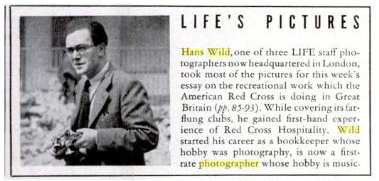
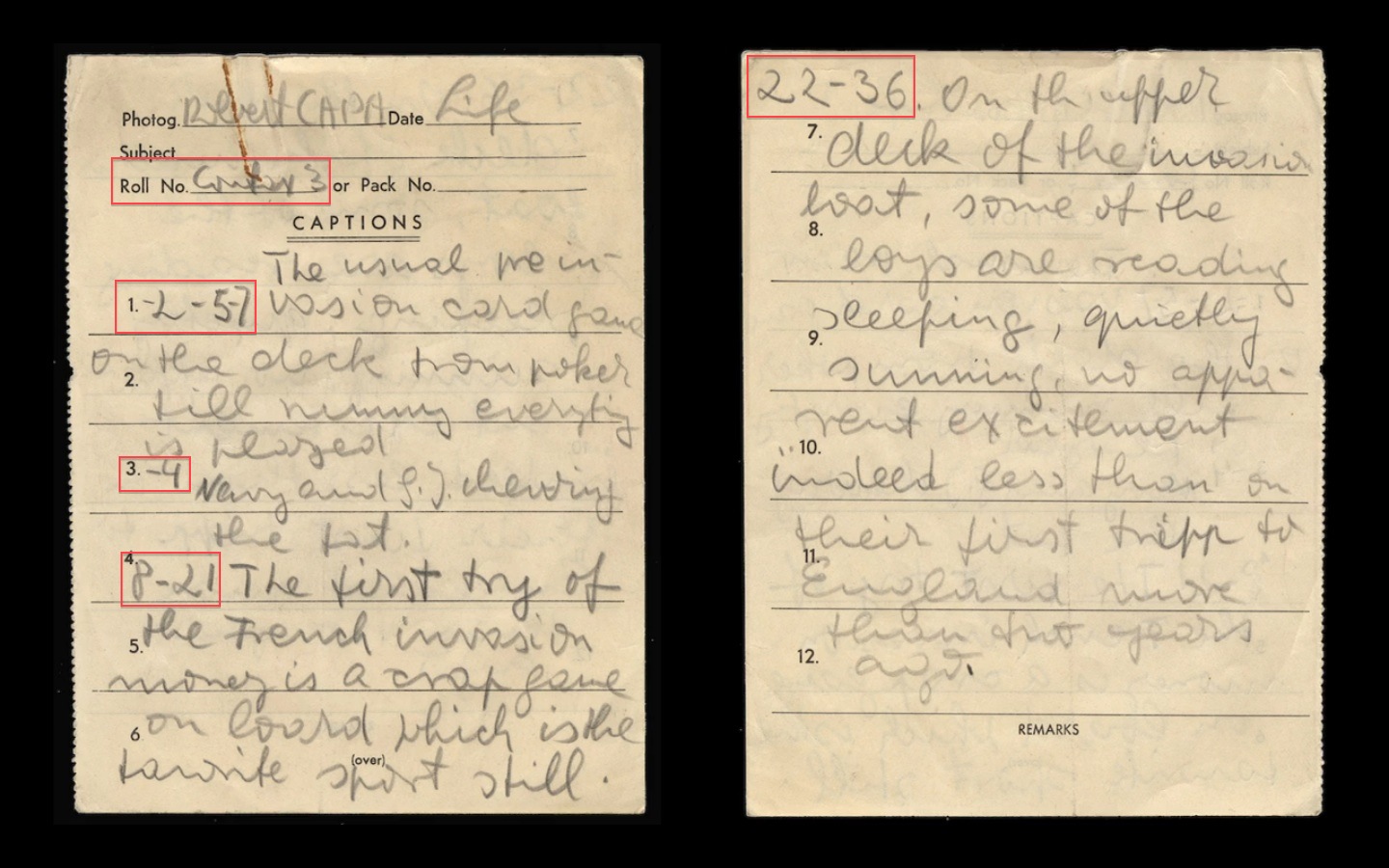




Leave a Comment